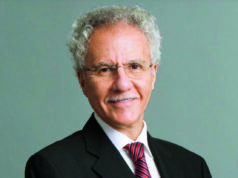
A debate at this year’s European Society for Vascular Surgery (ESVS 2024) annual meeting (Sept. 24–27) in Kraków, Poland, centered on innovation in vascular surgery, with experts considering whether it will “change everything.” While Matt Thompson, MBBS, chief executive officer of Endologix, underscored the inherently innovative nature of vascular surgery and the inevitability of technological advancement—he urged specialists to “safely adopt new technologies or become irrelevant”—vascular surgeon Jon Boyle, MBChB, a consultant vascular and endovascular surgeon at Cambridge University Hospitals NHS Foundation Trust in Cambridge, England, championed a more cautious, patient safety-focused approach, highlighting past instances of innovation having caused harm.
In the ongoing endovascular era, Thompson put forward, several innovations—including bioresorbable stents and non-invasive devices—have refined, or are set to refine, longstanding techniques and technologies. Indeed, the presenter said, there is “still room” for endovascular innovation, despite the largely unchanging nature of its fundamental building blocks. However, these innovations will not “change everything” in vascular surgery. Instead, he argued that the next paradigm shift in the field will be defined by technological change that is happening in the wider world. Thompson argued that the pace of technological advancement in society has already led to “enormous” changes in how people live their lives. What do technological advancements in the wider world mean for vascular surgery?
“There’s going to be some technological advance that completely changes our practice,” Thompson posited, listing wearable technology, personalized and regenerative medicine, and artificial intelligence (AI) and machine learning as just three technologies that have practice-changing potential. Thompson had a clear message here: adopt—safely—or be left behind.
‘We’ve got to be careful how we innovate’
Putting forward a counter argument, Boyle stressed the importance of striking a balance between innovation and patient safety. In several instances of innovation, Boyle argued, “we’ve actually got it wrong—we’ve innovated, and patients have come to harm.”
He referenced data from the landmark EVAR-1 trial, noting that patients who were randomized to endovascular aneurysm repair (EVAR) “had far greater numbers of interventions out to 14 years” than the patients who received open repair.
Acknowledging the age of the EVAR-1 data as a weakness of his argument, Boyle moved on to newer EVAR evidence, speaking on results from the VQI VISION study regarding the AFX graft (Endologix). The 2022 data, which illuminate reintervention and rupture rates with an early iteration of the device in the U.S., were published by Goodney et al in the British Medical Journal.
“When we fix an aneurysm, we’re trying to do it to prevent rupture, but the early AFX graft had a near 40% reintervention rate at eight years and a 10% rupture rate at 10 years,” Boyle informed the ESVS audience. In light of these data, Boyle remarked: “We’re fixing aneurysms, but we’re not really fixing them.” The presenter also shared similar findings with regard to fenestrated repair. He commented bluntly that “fenestration means twice the likelihood of being dead at three years,” according to data from Vallabhaneni et al’s UK-COMPASS study, published in 2024 in the European Journal of Vascular and Endovascular Surgery (EJVES).
Boyle presented data on peripheral arterial disease (PAD), citing a growing body of evidence showing that early intervention for claudication leads to worse outcomes. Referencing an Australian study from Golledge et al, published in 2018 in the British Journal of Surgery, the presenter shared that patients with intermittent claudication who were treated early with endovascular intervention had a five-year amputation rate of 6.2% compared to 0.7% for those who received best medical therapy and exercise. “Early intervention for intermittent claudication with new devices led to a significantly higher amputation rate in this patient cohort,” he summarized.
The story is similar with carotid stenting, Boyle said. “We’ve pretty much stopped doing carotid stenting in the UK,” he said. “The reason for that,” he explained, “is that for symptomatic disease, your relative risk of stroke and death following carotid stenting is 1.7 compared to carotid endarterectomy.”
Boyle returned to Endologix, this time focusing on Nellix. “We got our fingers burnt with this device,” the presenter acknowledged. “We all felt at the start this was a device that may change practice,” Boyle remembered. In the end, however, the presenter stressed that “a lot of patients came to harm as a result of being treated with this device.” Concluding, Boyle reiterated his central argument that “we’ve got to get the balance right—we need to innovate, but we need to do it in an environment where we can ensure our patients are safe.”












